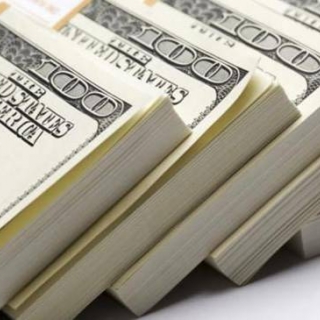


The dollar held steady on Tuesday, trading near a three-year low against the euro and a six-month trough against the yen, as investors trying to make sense of the constant changes to President Donald Trump'stariffs remained wary of U.S. assets.
Much of the volatility that hit the dollar last week and sent Treasury yields soaring appeared to have abated somewhat on Tuesday, although investor sentiment was still fragile.
The euro , which has been one of the biggest beneficiaries of this month's dumping of U.S. assets, was a touch weaker on the day at $1.1336, narrowly below last week's three-year high at $1.1474.
The dollar was slightly weaker at 142.99 yen, staying close to the six-month low of 142.05 it touched on Friday.
After slumping to a 10-year low against the Swiss franc last week, the dollar was 0.2% higher on Tuesday. Still, it is down nearly 8% against the Swiss franc this month, set for its biggest monthly drop since December 2008.
Market focus has been on the ever-shifting tariff headlines with the U.S. removing smartphones and other electronics from its duties on China over the weekend providing some relief, although comments from Trump suggested the reprieve is likely to be short-term.
Trump's imposition and then abrupt postponement of most tariffs on goods imported to the U.S. has sown confusion, adding to the uncertainty for investors and policymakers around the world.
There was a greater sense of calm across the market on Tuesday. But given the uncertainty Trump and his vacillation over tariffs have stirred up, analysts expected the reprieve for the dollar to be short-lived.
The yield on the benchmark U.S. 10-year Treasury note edged up 2 basis points to 4.38% after dropping nearly 13 basis points in the previous session.
Yields rose about 50 bps last week - their biggest weekly increase in over 20 years - as analysts and investors questioned U.S. bonds' status as the world's safest assets.
Fed Governor Christopher Waller said on Monday the Trump administration's tariff policies are a major shock to the U.S. economy that could lead the Federal Reserve to cut interest rates to head off a recession even if inflation remains high.
Traders are pricing in 86 bps of cuts from the Fed for the rest of the year, LSEG data showed.
The dollar index , which measures the U.S. currency against six others, was at 99.641, not far from last week's three-year low. The index is down over 4% this month, set for its biggest monthly drop since November 2022.
The more risk-linked currencies enjoyed a bout of strength. Sterling was up 0.1% at $1.347, while the Australian dollar rose 0.7% to $0.6371 and the New Zealand dollar gained 0.71% to reach $0.592, near its highest in four and half months.
Source : Reuters
The U.S. dollar edged up on Wednesday, extending its gains from last week on doubts about the outlook for another Fed rate cut this year and as private payrolls data assuaged worries over the state of...
The US dollar held near a three-month high on Tuesday (November 4th) as a divided Federal Reserve prompted traders to reduce their bets on a rate cut, while the Japanese yen strengthened after a verba...
The US dollar held near a three-month high on Monday (November 3rd) ahead of economic data this week that will provide only vague clues about the health of the US economy and could reinforce the Feder...
The US Dollar Index (DXY) held steady around 99.50 during the Asian session on Friday (October 31st). The greenback's movement was slight as market expectations for a Fed interest rate cut strengthene...
The US dollar traded higher for the second consecutive day against a basket of currencies. The greenback strengthened sharply on Wednesday, following hawkish comments from Fed Chairman Jerome Powell, ...
Gold prices approached $4,000/oz on Friday (November 7th) after weak US jobs data reinforced expectations of an imminent Fed rate cut. Challenger job cuts nearly tripled in October—the largest increase in more than two decades—dampening optimism...
Hong Kong stocks fell 197 points, or 0.8%, to 26,282 in Friday's morning session, retreating after their biggest one-day gain since mid-August amid caution ahead of China's October trade data. Exports are expected to slow sharply after months of...
The Trump administration suspended docking fees for Chinese-built ships as part of a "trade truce" last month. The move has drawn criticism for weakening U.S. efforts to protect port access—so-called privileges—and increasing supply chain...
 Asia-Pacific markets declined on Wednesday, following a decline on Wall Street, which was driven by concerns about the valuations of artificial...
Asia-Pacific markets declined on Wednesday, following a decline on Wall Street, which was driven by concerns about the valuations of artificial...
 The Institute for Supply Management (ISM) is scheduled to release its October Services Purchasing Managers' Index (PMI) on Wednesday. The report, a...
The Institute for Supply Management (ISM) is scheduled to release its October Services Purchasing Managers' Index (PMI) on Wednesday. The report, a...
 World markets kicked off November in an upbeat mood, riffing off buoyant company earnings and calmer trade relations while batting away OPEC's...
World markets kicked off November in an upbeat mood, riffing off buoyant company earnings and calmer trade relations while batting away OPEC's...
 The ISM Services PMI rose to 52.4 in October 2025 from 50 in September, beating forecasts of 50.8, pointing to the strongest expansion in the...
The ISM Services PMI rose to 52.4 in October 2025 from 50 in September, beating forecasts of 50.8, pointing to the strongest expansion in the...